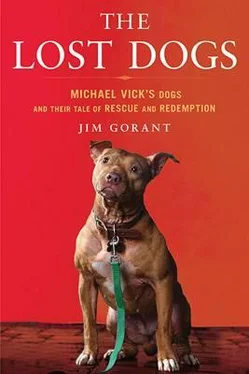The site went up a few weeks later and within days Reynolds realized they had tapped into something much bigger than they’d ever imagined. They had hundreds of inquiries from all over the country; people were looking for information on pit bulls. How to train them, what to feed them, how much exercise they needed. There were people looking to place dogs and people looking to adopt dogs.
Reynolds and Racer gave up their work with birds of prey and focused on pit bulls. They were uniquely prepared for the task of taking shelter dogs, teaching them some manners, and then finding them homes. Over the years they had taken in, nursed, and trained dozens of dogs, culminating with Mr. B, who made all the others look easy. The raptor rescue had helped, too-anyone who can get a wild eagle to literally eat out of his hand can probably get a pit bull to walk nicely on a leash.
Their connection to Old Dog became more valuable than ever. He gave them key insights into the breed’s behavior, tendencies, history, and traits, and he answered their questions. Reynolds and Racer threw themselves into the work. “We never made a conscious decision not to have kids,” Reynolds says. “We always sort of thought we would one day get the urge, but we never did, and I think we channeled a lot of that parenting energy into the dogs.”
As part of the plan, BAD RAP took only the best dogs-ambassador dogs-which they chose after a rigorous evaluation. They set up obedience classes for pit bull owners and insisted that new adopters attend at least one class with the dog they were hoping to take home beforehand and four more classes afterward. Those adopters also had to submit to a home inspection and everyone was encouraged to come back for advanced classes. Instead of being set up to fail, as they felt so many pit bulls were, these dogs would be hardwired to succeed. They would go into the world and prove how safe and reliable pit bulls could be.
But the BAD RAP crowd knew from experience that more than placing individual dogs, the best way to save the breed was to fight back against the negative perceptions. Education and advocacy became as important as rescue. They began consulting with shelters and other pit bull rescue groups about how to evaluate dogs, screen adopters, set up training programs, and best maintain kenneled dogs. Their Web site became a database, including articles on pit bulls, news about fight busts around the country, and a message board that hosted lively discussions about pit bull-related issues.
In time the group grew to forty volunteers and had a permanent presence in the Oakland animal shelter. The arrangement included a separate room in the corner of the facility where they could house the dogs they’d accepted into their program. It let them better control the atmosphere, providing a saner, quieter place that allowed the dogs to keep it together longer in the shelter. They also set up a wood chip- filled exercise and play area out back and an office in an old trailer they picked up off Craigslist from a parachuting company that had gone bust. Every day BAD RAP volunteers came to the shelter to work with the dogs, getting them out for exercise, training, and playtime. Donna and Tim did evaluations, home inspections, ran the training classes, and set up adoptions and foster care.
The couple had remortgaged their house three times to keep the operation running when donations ran low, but by 2006 BAD RAP’s finances were solid. Donna was spending eighty hours a week doing BAD RAP work, which had caused her art career to all but disappear, so she finally began taking a salary. Tim maintained a successful business carving wooden replicas of people’s family pets, but he was slowed by the forty hours a week he spent on BAD RAP, so the following year he too accepted a small salary for his efforts.
From the beginning they had followed the Vick case closely, trying to figure out a way to help. In early June, about six weeks after the initial raid at Moonlight Road, Reynolds heard that the Humane Society was stepping in to handle the animals. She was ecstatic. She had a relationship with HSUS and had recently worked with them in the aftermath of Hurricane Katrina. BAD RAP had come in to help rescue some of the hundreds of dogs that were abandoned or lost during the storm. Tim and Donna had brought their typical approach, saving the best and putting down those that were suffering or unable to present the breed in a positive light. Reynolds felt this practical approach had won them some favor with HSUS and the federal government; it proved they weren’t weak-kneed apologists incapable of making hard decisions.
As soon as she heard the HSUS news, Reynolds raced to her computer and started typing a proposal. Nine pages later she had outlined her group’s history, its success adopting out household pets, and its track record providing candidates for law enforcement work. Finally, the proposal laid out a plan to individually evaluate each of the Vick dogs. She was certain at least a few of them would be worthy of saving if only they were given a chance-and if they didn’t linger too long in the shelters. She finished writing at 5:00 A.M., walked the envelope to the mailbox, and dropped it in.
Nothing. She got no response. But she stuck with it. When the federal government took over the case she poked around the legal filings until she came across Mike Gill’s name. She printed out another copy of her proposal and mailed it to him. It landed on Gill’s desk about the same time he was consulting Dr. Z about what would become of the dogs. Gill was struck by the similarity of the approach advocated by BAD RAP, so he passed the proposal on to Zawistowski. Dr. Z had never met Donna and Tim but he was familiar with their work, so when he sat down to put together his team of expert evaluators, he included them on the list.
Now, eight years and more than four hundred rescued pit bulls after they began, Donna Reynolds and Tim Racer were on their way to a secure government meeting where they would take their places on a secret committee of experts assembled to assess the victims of what was already the most notable and important dogfighting case in history.
AS STEV E ZAW ISTOWSKI CALLED to order the first meeting of his hand-picked pit bull evaluation team, he felt like a character in a movie. Although the meeting was taking place in the nondescript conference room of a suburban Radisson, the space contained armed federal agents. Gag orders had been signed, and U.S. marshals waited outside to secret the team off on its mission.
Dr. Z hadn’t expected any of that. In fact, he’d been working hard to keep his expectations in check. The number he had in his head was 10 percent. He believed in animals. He’d studied their abilities and tested their limits. He’d seen them overcome incredible things. He thought, as the meeting began, if they could save 10 percent of the remaining dogs, it would be a noteworthy achievement.
They were down to forty-nine. In the original raid fifty-one pit bulls were seized. Since then, two had died while in custody, although little was known about how or why and likely never would be. But 10 percent of forty-nine was five dogs, and Dr. Z held out hope for that many.
He was not alone. On the plane ride to Richmond, Reynolds and Racer had set a goal of five. They thought they would be able to find five workable, adoptable dogs. Almost no one in the room dreamed of a number higher, and some wondered if there would be any. The words of HSUS president and CEO Wayne Pacelle kept ringing in their ears: “Our people have evaluated these dogs, and they’re some of the most viciously trained dogs in the country…”
The high-profile nature of the situation intensified the meaning. There could be no accidents, no oops moments. These dogs would be cheered, feared, written about, spied on, and watched for years. They would set precedents and establish boundaries for what was and was not possible, not only for pit bulls rescued from fight operations but for pit bulls as a breed.
Читать дальше












